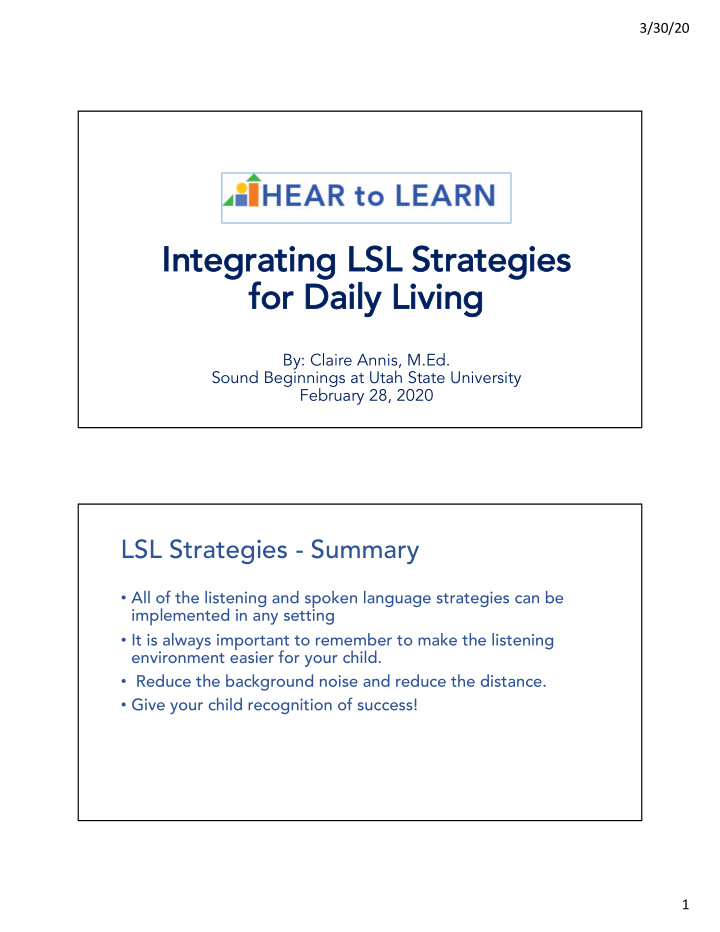



3/30/20 In Integrating L LSL S Strategies fo for Daily Living By: Claire Annis, M.Ed. Sound Beginnings at Utah State University February 28, 2020 LSL Strategies - Summary • All of the listening and spoken language strategies can be implemented in any setting • It is always important to remember to make the listening environment easier for your child. • Reduce the background noise and reduce the distance. • Give your child recognition of success! 1
3/30/20 LSL Strategies: • Auditory First • Self-Talk • Auditory Bombardment • Parallel Talk • Auditory Sandwich • Expansion & Extension • Sabotage • Wait Time • Auditory Closure • Acoustic Highlighting (including, Whisper) • Parentese Learning Objectives • Build confidence in ability to incorporate Listening and Spoken Language strategies into natural daily living situations. • Gain strategies to help children reach their 40 million word goal. https://hearingfirst.org/en/blog/2018/05/22/Reach-the-40- Million-Word-Goal • Become aware of strategies you are using already using without noticing. 2
3/30/20 Auditory First “say, then show” Why? • Break reliance • Build focus • Strengthen “muscle” 3
3/30/20 How? “Younger” “Older” • Keep it simple • Give clues • LSL sounds • Books • Hide n’ seek • Playing • Engagement Auditory Bombardment “repeat” 4
3/30/20 Why? • New vocabulary • Use How? “Younger” “Older” • DIP • Omitted words • LSL sounds w/i play • Vocabulary/Tier 2 • New Vocabulary • Expect attention • Expect attention 5
3/30/20 Auditory Sandwich “say, show, say” Why? • Support • Practice 6
3/30/20 How? “Younger” “Older” • Simple directions • Directions (tier 2) • Fingerplays • Vocabulary • Itsy Bitsy Spider • Story-time • Learning to Listen o ahh-airplane-ahh Sabotage “be silly” 7
3/30/20 Why? • Independence • Attention How? **Be aware of foundational knowledge “Younger” “Older” • Limited access • Do something wrong o Too hard o correction o Too high o Not enough • Limited access • Say something wrong 8
3/30/20 Auditory Closure “finish the line” Why? • Context • Advocacy 9
3/30/20 How? “Younger” “Older” • Nursery rhymes • Story-time • Routines (1, 2, 3 …) • Familiar songs • Analogies Parentese “parent talk” 10
3/30/20 Why? • Vocabulary • Attention How? “Younger” “Older” • Less is more • Engagement • Repetition • Sing-Song 11
3/30/20 Self Talk “say what you see” Why? • Meaningful language 12
3/30/20 How? “Younger” “Older” • Narration • Narration • 1 st person • 1 st person Parallel Talk “say what they see” 13
3/30/20 Why? • Meaningful language How? “Younger” “Older” • Narration (child’s actions) • Narration • 1 st and 2 nd person • 2 nd person 14
3/30/20 Expansion “add more” Why? • Longer utterances • Build vocabulary 15
3/30/20 How? “Younger” “Older” • Anticipate thoughts • Lengthen • Lengthen • Link (extend) Wait Time “7-10 seconds” 16
3/30/20 Why? • Extra processing • Time to respond How? **Create a lifelong habit “Younger” “Older” • Expectant look • Directions • Pair with sabotage • Questions • Create opportunities for response 17
3/30/20 Acoustic Highlighting “listen” Why? • Missing parts • Listen easier 18
3/30/20 How? “Younger” “Older” • Sing-song • Stress • FUN • Stretch • Stress • Volume • Stretch • Whisper • Volume Questions Ques ns/Co /Comment mments? Re Resou ources: -hear hearing ngfirst.o .org -hear heartolear earn.o n.org 19
Recommend
More recommend